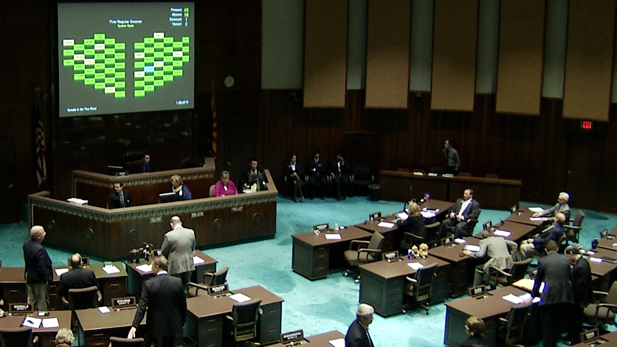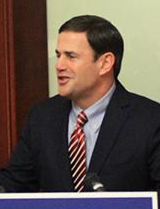 The Arizona House of Representatives, in a 2013 floor session.
The Arizona House of Representatives, in a 2013 floor session.Listen:
Gov. Doug Ducey signed a $3.5 billion, 10-year funding plan for K-12 public schools into law Friday, about an hour after it cleared its last hurdle in a legislative special session.
The plan, cobbled together to settle a lawsuit by schools over lack of funding and to try lifting the state from being the worst in the nation for education funding, passed the House Thursday night and the Senate during the noon hour Friday.
In both chambers, the three-bill package drew party-line votes on two provisions and unanimous consent on the third bill, which actually provides the funding.
 Arizona Gov. Doug Ducey.
Arizona Gov. Doug Ducey.
“This is a great day for Arizona kids, families and teachers," Ducey said in a statement. "We all know there is plenty of gridlock and partisanship in politics, but through this effort, we have proven that if we work together, in a spirit of good faith, we can improve the lives of Arizonans."
The package includes Ducey's proposal to increase the percentage of money taken from the State Land Trust Fund and give it to schools.
That contentious provision means voters will have the final say, because it requires a constitutional amendment. A special election is set for next May.
If approved, K-12 public schools in the state would get a $249 million payment before the end of the fiscal year in June. That would add about $226 per student but still leave Arizona near the bottom in school funding and teacher pay.
The Joint Legislative Budget Committee released an analysis in August that showed state funding in the current budget for K-12 education is $3,437 per student, 19.2 percent lower than 10 years earlier when adjusted for inflation.
The first payout under the special session legislation would come from the state's general fund, which currently has a $330 million surplus that has grown each month this year. In addition, the state has $458 million in its rainy day fund.
Part of the plan would settle a 5-year-old lawsuit by schools against the Legislature for cutting out inflation adjustments to education funding during and after the recession. A judge ruled that illegal and ordered the state to add $331 million to school funding, but the case has been hung up in negotiations for two years.
Also in the plan is a proposal to increase what the state pays to schools from the State Land Trust Fund, which was set up at statehood and has $5.1 billion in it. Currently, the payout is 2.5 percent of interest and earnings, and Ducey and Republican legislators will ask voters to increase that to 6.9 percent for 10 years.
Opponents of the idea have said it will require tapping into the fund's principle, leaving less money for schools in the future.
Another provision that drew opposition was a cap on the percentage of total state spending that can go to schools. If it exceeds 49 percent, funding can be cut.
The Republican-controlled Legislature passed and Ducey signed a budget in March that cut funding for K-12 education by $113 million from a formula legislators had adopted last year. They immediately drew criticism from a wide array of interests, including Democrats and the education community.
Shortly after that, the U.S. Census Bureau reported Arizona was the worst in the country for per-student school funding, and that was followed by a report that Arizona teachers were among the nation's lowest paid.
The information fed criticism and led Ducey to come up with the State Land Trust Fund plan.

By submitting your comments, you hereby give AZPM the right to post your comments and potentially use them in any other form of media operated by this institution.